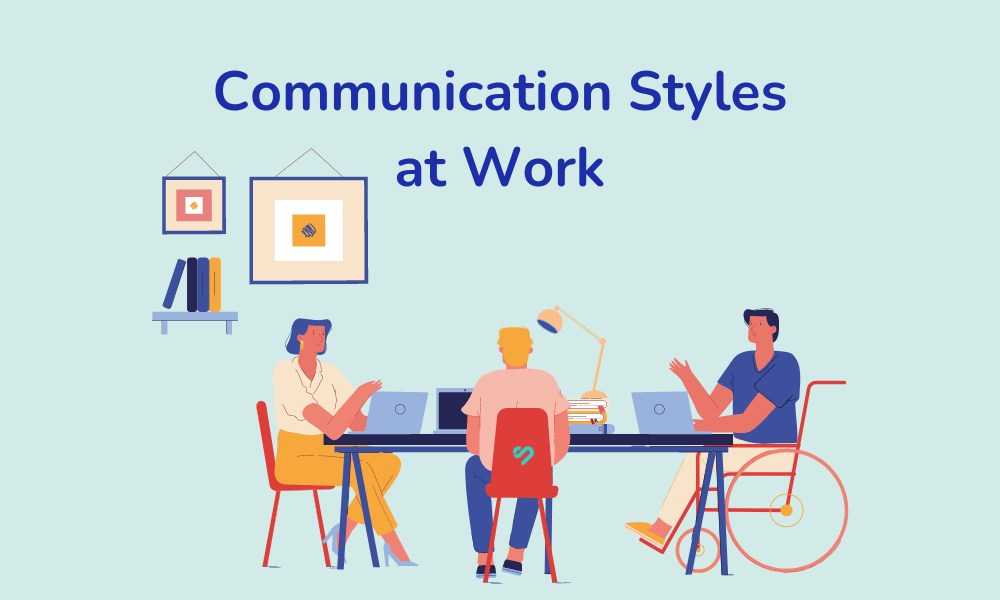
Have you experienced the perplexing moments of differing communication styles at work, where your brilliant ideas were lost in a game of telephone or misunderstood like an inside joke gone wrong?
Picture this: sending a professional email that inadvertently turned into a comedic masterpiece or engaging in a conference call where everyone seemed to speak a different language.
Pro-Tip from The Assist: “Be a smooth talker, not a tangled word juggler” means emphasizing the importance of expressing oneself clearly and effectively, avoiding unnecessary complexity or confusion in communication.
When it comes to achieving success in the workplace, understanding the significance of communication styles is paramount.
How can you enhance collaboration, resolve conflicts, and create a positive work environment through strategic communication?
The key to unlocking effective collaboration, conflict resolution, and a positive work environment lies within our guide, offering strategies that empower individuals to confidently navigate diverse communication styles.
Acquire valuable strategies to boost collaboration, navigate conflicts with finesse, and cultivate a harmonious and uplifting workplace, all through the power of effective communication.
Tip! Try these FREE email newsletters to gain resources and insights into being a better professional:
| The Assist | 💼 Become a better professional in under 5 minutes | Subscribe Here |
| FounderIV | ⚡Achieve breakout founder performance with this free weekly email | Subscribe Here |
| Human Crapital | 🤭 Helping you avoid embarrassing, uncomfortable, and common HR mistakes | Subscribe Here |
5 Different Communication Styles at Work
Understanding and adapting to the types of communication styles has become even more essential in today’s dynamic and interconnected work environments.
The virtual stage on which we perform demands heightened empathy, active listening, and adaptability to various cultural nuances. By mastering the art of effective communication, we can transcend physical barriers, nurture trust, and create a virtual symphony of productivity and collaboration.
Explore the 5 main communication styles and find which one you are and those of your teammates.
1. Assertive Communication Style
An assertive communication style can be defined as a confident and reasonable approach to expressing one’s thoughts, feelings, and needs while respecting the rights and opinions of others. It involves effectively and respectfully communicating one’s ideas, boundaries, and desires, without becoming passive or aggressive.
Examples of assertive communication style:
- Speaking up for oneself: When someone tries to take advantage or mistreat them, an assertive communicator addresses the issue directly
Example: “I feel uncomfortable when you speak to me in that tone. I would appreciate it if you could communicate with me more respectfully.”
- Expressing personal boundaries: An assertive communicator clearly articulates their limits.
Example: “I’m unable to take on additional tasks right now, but I’d be happy to help once I finish my current workload.”
- Active listening: Assertive communicators actively listen to others, demonstrating their engagement and understanding. They respond empathetically, paraphrasing and reflecting on what the other person has said.
Example: “If I understand correctly, you’re concerned about the project deadline. Let’s discuss how we can address that.”
2. Passive Communication Style
Passive communication style can be defined as an interpersonal approach in which individuals tend to avoid expressing their thoughts, feelings, needs, or boundaries, often yielding to others’ opinions or accommodating their demands. Individuals with a passive communication style often prioritize avoiding conflict or upsetting others over asserting their own opinions and desires.
However, this style may result in unmet needs, suppressed emotions, and a lack of assertiveness in personal and professional relationships.
Examples of passive communication style:
- Agreeing with others even when you have a different opinion, just to avoid conflict or confrontation.
Example: “Sure, whatever you think is best.”
- Apologizing excessively, even when you are not at fault or responsible for the situation.
Example: “I’m sorry for inconveniencing you. It’s entirely my fault.”
- Avoiding eye contact and using a soft or timid voice when expressing your ideas or concerns, diminishing your presence.
Example: “It was nothing. Anyone could have done it.”
3. Aggressive Communication Style
An aggressive communication style can be defined as an interpersonal approach characterized by forceful, confrontational, and disrespectful behavior when expressing thoughts, feelings, needs, or boundaries. Individuals with an aggressive communication style prioritize their own needs and desires over the feelings and perspectives of others, often using intimidation, domination, or verbal attacks to assert their opinions and control conversations.
Examples of aggressive communication style:
- Using derogatory language, insults, intense eye contact, or personal attacks to belittle or demean others during a disagreement or argument.
Example: “You’re so clueless. It’s no wonder you can’t grasp even the simplest concepts.”
- Ignoring or dismissing the perspectives, ideas, or feelings of others, considering only your viewpoint as valid or important.
Example: “You’re always wrong. I can’t believe I have to deal with your incompetence.”
- Disregarding others’ boundaries and personal space, invading their boundaries without consent.
Example: “I can’t stand working with you. Your presence is a constant source of irritation.”
4. Passive-Aggressive Communication Style
A passive-aggressive communication style can be defined as an indirect and subtly hostile approach to expressing thoughts, feelings, needs, or concerns. Individuals with a passive-aggressive style often mask their true intentions or emotions, making it challenging for others to address issues directly. With the use of sarcasm, backhanded compliments, or subtle jabs to convey their discontent or manipulate situations, all while maintaining a façade of politeness or innocence.
Examples of passive-aggressive communication style:
- Instead of directly addressing a miscommunication issue, a passive-aggressive individual might make sarcastic remarks or give subtle, snide comments.
Example: “Oh, so we’re going with your brilliant plan? I guess the rest of us don’t have any ideas worth considering.”
- When faced with a decision they disagree with, a passive-aggressive person may use subtle guilt-tripping or manipulation to influence the outcome at the expense of others.
Example: “Oh, well, I guess it’s fine if everyone else wants to go ahead. I’ll just have to deal with the consequences alone.”
- Instead of addressing conflicts directly, a passive-aggressive person may resort to giving silent treatment or withdrawing from interactions.
Example: Ignoring messages or emails related to the conflict without offering any explanation or resolution.
5. Collaborative Communication Style
A collaborative communication style can be defined as an approach characterized by open, respectful, and inclusive communication that fosters cooperation, active listening, and shared problem-solving. It involves individuals working together as functional communicators to exchange ideas, actively listen, and seek common ground to achieve common goals.
Examples of collaborative communication style:
- Celebrating successes and milestones together, acknowledging the collaborative effort, and recognizing the achievements of the team as a whole.
Example: “I appreciate your input on this matter. Let’s have a discussion to ensure good communication and alignment of our perspectives before making a decision.”
- Collaborating across different departments or teams, breaking down silos, and fostering a sense of shared purpose and unity.
Example: “I must say, your ideas are refreshing. Let’s navigate together and find our way to a brilliant solution.”
- Encouraging open dialogue and inviting diverse opinions, valuing the input of every team member, and creating an inclusive space for discussion.
Example: “Your direct feedback is incredibly helpful. Let’s seize this opportunity to exchange ideas openly and shape our collective vision.”
Importance of Effective Communication
Whether in personal relationships, professional settings, or societal interactions, effective communication skills serve as the bedrock of harmonious connections. It enables us to navigate conflicts, resolve misunderstandings, and reach common ground. It empowers us to inspire, motivate, and influence others positively.
Enhancing Interpersonal Relationships
In an environment of enhancing interpersonal relationships, clear and concise communication acts as a bridge, connecting individuals and facilitating a deeper level of understanding.
When we express our thoughts, ideas, and expectations clearly and concisely, we minimize ambiguity and foster shared know-how. This shared understanding builds trust and helps to establish a firm foundation for effective collaboration and cooperation.
From team-building retreats that unleash the spirit of camaraderie to informal coffee chats that spark creativity, every interaction is an opportunity to develop a stronger and more vibrant workplace community. After all, a shared smile, a reassuring word, and a high-five of encouragement can indeed transform the fabric of our professional lives.
Building Trust and Rapport
For professional relationships, building trust and rapport remains a cornerstone for success. When trust is established, individuals feel comfortable, supported, and connected, allowing for more effective collaboration and a harmonious work environment.
Clear and concise communication serves as a vital ingredient in the recipe for building trust and rapport, offering a range of benefits that contribute to a thriving workplace.
Trusting relationships allow for open communication, constructive feedback, and the freedom to take risks without fear of judgment. Whether it’s through active listening, honoring commitments, or showing appreciation for each other’s strengths, building trust and rapport promotes an environment where innovation flourishes and accomplishments soar to new heights.
Resolving Conflicts and Avoiding Misunderstandings
In workplace dynamics, conflicts, and misunderstandings are bound to arise. Resolving conflicts effectively and avoiding misunderstandings are crucial for maintaining a harmonious and productive work environment.
When individuals engage in open and transparent dialogue, clearly articulating their concerns, perspectives, and needs, it lays the groundwork for productive conflict resolution.
Colleagues engage in healthy debates, transforming potential conflicts into opportunities for growth. From defusing tension through active listening to unleashing the power of empathy to diffuse misunderstandings, conflict resolution becomes a thrilling dance of diplomacy.
Imagine a workplace where disagreements are met with open minds, perspectives are valued, and resolution paves the way for collaboration and innovation.
Strategies to Improve Workplace Communication
Picture a workplace where every message is crafted with care, leaving no room for confusion or misinterpretation. Where conversations become meaningful exchanges, and conflicts transform into opportunities for growth and resolution.
As you embrace these practical tips, you’ll witness the transformation of your communication skills, creating a ripple effect that enhances team dynamics, boosts morale, and elevates productivity. No more confusion or missed deadlines; you’ll be the master of timelines and efficiency.
Active Listening Techniques
Practice active listening by giving your full attention to the speaker, maintaining eye contact, paying attention to body language, and avoiding distractions. Truly listen to understand, ask clarifying questions, and paraphrase to ensure comprehension.
Developing Empathy and Emotional Intelligence
Cultivate empathy by putting yourself in others’ shoes. Seek to understand their perspectives, feelings, and needs. This empathetic approach fosters better communication and builds stronger relationships.
Clarifying Expectations and Instructions
Clarify expectations by setting clear goals, deadlines, and deliverables. Ensure everyone is on the same page regarding responsibilities and outcomes. Regularly check in with team members to assess progress and address any ambiguities promptly.
Impact of Communication Styles on Productivity and Collaboration
Understanding the impact of different communication styles on team dynamics is crucial for promoting productivity and collaboration. Embracing an assertive style communicator, which values open dialogue, active listening, and respect for diverse perspectives, can foster a positive team environment.
By recognizing and adapting to different personal communication styles, teams can harness the strengths of each team member, encourage meaningful collaboration, and maximize overall productivity and success.
Communication Styles and Teamwork
The workplace communication style of each team member serves as a lens through which they interpret and convey information. Recognizing and respecting these individual styles lays the foundation for stronger teamwork.
However, simply acknowledging differences is not enough—true collaboration thrives when team members adapt their communication styles to align with the needs of the collective. By adapting communication styles to match the decision-making process, teams can strike a balance between assertiveness and collaboration, maximizing the collective intelligence and input of all members.
Overcoming Barriers to Effective Communication
Overcoming barriers to effective communication requires recognizing the importance of adapting communication styles. Aligning communication with the big picture promotes a sense of purpose and commitment to organizational goals.
Recognizing and accommodating diverse communication preferences breaks down hierarchical structures and encourages cross-functional collaboration. Sensitivity to cultural and language differences fosters inclusivity. By adapting communication styles, teams can enhance collaboration, maximize employee engagement, and create a vibrant and cohesive work environment that fuels success.
People Also Ask These Questions About Communication Styles at Work
Q: What are the different communication styles in the workplace?
- A: Most effective communication in the workplace frequently incorporates elements from multiple styles. A flexible and adaptable approach, taking into account the context and needs of the situation, allows individuals to tailor their communication style for optimal results. Different communication styles shape the interactions and dynamics among colleagues. Understanding and recognizing these styles is crucial for fostering effective communication and maximizing productivity.
Q: How do different communication styles affect teamwork?
- A: Different communication styles have a profound impact on teamwork. Factors such as fidgeting, facial expressions, engagement level, clarity, and the ability to interpret non-verbal communication cues all contribute to the overall dynamics within a team. Recognizing and understanding these different styles allows team members to adapt their communication approaches, fostering better collaboration, improved understanding, and ultimately, enhanced teamwork. By embracing diverse communication styles and leveraging their strengths, teams can tap into the full potential of each member and achieve greater collective success.
Q: How can I adapt my communication style to different personalities?
- A: Adapting one’s communication style to different personalities is a valuable skill that can greatly enhance the employee experience and foster stronger relationships in the workplace. By recognizing and appreciating the preferences and tendencies of analytical, empathetic, assertive, and intuitive communicators, you can tailor your approach to create more engaging and productive interactions. This adaptability fosters stronger connections, promotes collaboration, and ultimately leads to a more fulfilling and harmonious workplace environment.
Q: What are the best practices for virtual communication at work?
- A: Establishing a culture that encourages active participation is vital for successful virtual communication. Team members should be empowered to ask a lot of questions, seek clarification, and express their thoughts openly. Remote communication at work involves leveraging technology integrations, encouraging open communication, utilizing visual aids, practicing active listening, maintaining professionalism, and fostering social connections.
Q: How can I overcome language and cultural barriers in workplace communication?
- A: Overcoming language and cultural barriers in workplace communication requires self-awareness, adaptability, and a commitment to inclusivity. Recognizing and addressing these barriers can create an environment that celebrates diversity, fosters understanding, and promotes effective collaboration. Understanding that each type of person has a unique cultural background and linguistic capabilities. We can build bridges of communication that transcend language and cultural differences, fostering a harmonious and successful workplace.







Wow, what a fantastic read! This article perfectly captures the challenges of differing communication styles at work and provides valuable strategies to overcome them. Understanding the impact of different styles on productivity and collaboration is crucial, and the tips for improving workplace communication are spot-on. Thank you for sharing this insightful piece!